Development and Application of an Electrochemical Sensor with 1,10-Phenanthroline-5,6-dione-Modified Electrode for the Detection of Escherichia coli in Water
Abstract
:1. Introduction
2. Materials and Methods
2.1. Reagents
2.2. Apparatus
2.3. Preparation of Electrochemical Sensor
2.4. Culture of E. coli
2.5. Detection of NADH Using As-Prepared Electrochemical Sensor
2.6. Detection of E. coli Using As-Prepared Electrochemical Sensor
2.7. Detection of E. coli Using Colorimetric Method
3. Results and Discussion
3.1. The Detection Principles of As-Prepared Electrochemical Sensor
3.2. Surface Characterization of PD-Modified Electrode
3.3. Electrochemical Characterization of PD-Modified Electrode
3.4. The Performance of As-Prepared Electrochemical Sensor in NADH Detection
3.5. Detection of E. coli by As-Prepared Electrochemical Sensor
3.6. E. coli Detection in Real Water Samples
4. Conclusions
Author Contributions
Funding
Institutional Review Board Statement
Informed Consent Statement
Data Availability Statement
Conflicts of Interest
References
- Guo, X.D.; Han, J.Z.; Li, J.Y.; Wang, Z.B.; Zhang, Z.H.; Kang, X.; Zhu, W.; Deng, H.B. Water hazard detection: A 20-year review. J. Terramechanics 2023, 105, 53–66. [Google Scholar] [CrossRef]
- Ribeiro, V.H.A.; Moritz, S.; Rehbach, F.; Reynoso-Meza, G. A novel dynamic multi-criteria ensemble selection mechanism applied to drinking water quality anomaly detection. Sci. Total Environ. 2020, 749, 142368. [Google Scholar] [CrossRef]
- Zulkifli, S.N.; Rahim, H.A.; Lau, W.J. Detection of contaminants in water supply: A review on state-of-the-art monitoring technologies and their applications. Sens. Actuators B Chem. 2018, 255, 2657–2689. [Google Scholar] [CrossRef] [PubMed]
- Nnachi, R.C.; Sui, N.; Ke, B.W.; Luo, Z.H.; Bhalla, N.; He, D.P.; Yang, Z.G. Biosensors for rapid detection of bacterial pathogens in water, food and environment. Environ. Int. 2022, 166, 107357. [Google Scholar] [CrossRef] [PubMed]
- Huang, Y.R.; Chen, W.J.; Chung, J.; Yin, J.; Yoon, J. Recent progress in fluorescent probes for bacteria. Chem. Soc. Rev. 2021, 50, 7725–7744. [Google Scholar] [CrossRef]
- Syal, K.; Iriya, R.; Yang, Y.Z.; Yu, H.; Wang, S.P.; Haydel, S.E.; Chen, H.Y.; Tao, N.J. Antimicrobial Susceptibility Test with Plasmonic Imaging and Tracking of Single Bacterial Motions on Nanometer Scale. ACS Nano 2016, 10, 845–852. [Google Scholar] [CrossRef]
- Li, Y.S.; Zhu, J.W.; Zhang, H.Y.; Liu, W.M.; Ge, J.C.; Wu, J.S.; Wang, P.F. High sensitivity gram-negative bacteria biosensor based on a small-molecule modified surface plasmon resonance chip studied using a laser scanning confocal imaging-surface plasmon resonance system. Sens. Actuators B Chem. 2018, 259, 492–497. [Google Scholar] [CrossRef]
- Andrei, C.C.; Moraillon, A.; Lau, S.; Felidj, N.; Yamakawa, N.; Bouckaert, J.; Larquet, E.; Boukherroub, R.; Ozanam, F.; Szunerits, S.; et al. Rapid and sensitive identification of uropathogenic Escherichia coli using a surface-enhanced-Raman-scattering-based biochip. Talanta 2020, 219, 121174. [Google Scholar] [CrossRef]
- Tadesse, L.F.; Ho, C.S.; Chen, D.H.; Arami, H.; Banaei, N.; Gambhir, S.S.; Jeffrey, S.S.; Saleh, A.A.E.; Dionne, J. Plasmonic and Electrostatic Interactions Enable Uniformly Enhanced Liquid Bacterial Surface-Enhanced Raman Scattering (SERS). Nano Lett. 2020, 20, 7655–7661. [Google Scholar] [CrossRef]
- Xu, D.K.; Chen, H.Y. Electrochemical Detection for Arrayed Electrode Chips. Prog. Chem. 2009, 21, 2379–2387. [Google Scholar]
- Wu, J.; Liu, H.; Chen, W.; Ma, B.; Ju, H. Device integration of electrochemical biosensors. Nat. Rev. Bioeng. 2023, 1, 346–360. [Google Scholar] [CrossRef] [PubMed]
- Chen, Y.H.; Gao, X.L.; Liu, G.S.; Zhu, R.T.; Yang, W.L.; Li, Z.S.; Liu, F.M.; Zhou, K.C.; Yu, Z.M.; Wei, Q.P.; et al. Correlation of the role of boron concentration on the microstructure and electrochemical properties of diamond electrodes. Funct. Diam. 2022, 1, 197–204. [Google Scholar] [CrossRef]
- Dong, X.Y.; Zhao, W.W.; Sun, G.B.; Xu, J.J.; Chen, H.Y. An Electrochemical DNA Biosensor Based on Gold Nanofilm and Stable Y Junction Structure. Acta Chim. Sin. 2012, 70, 1457–1463. [Google Scholar] [CrossRef]
- Tong, P.; Zhang, L.; Xu, J.J.; Chen, H.Y. Simply amplified electrochemical aptasensor of Ochratoxin A based on exonuclease-catalyzed target recycling. Biosens. Bioelectron. 2011, 29, 97–101. [Google Scholar] [CrossRef]
- Du, D.; Ju, H.X.; Zhang, X.J.; Chen, J.; Cai, J.; Chen, H.Y. Electrochemical immunoassay of membrane P-glycoprotein by immobilization of cells on gold nanoparticles modified on a methoxysilyl-terminated butyrylchitosan matrix. Biochemistry 2005, 44, 11539–11545. [Google Scholar] [CrossRef] [PubMed]
- Luo, C.H.; Lei, Y.N.; Yan, L.; Yu, T.X.; Li, Q.; Zhang, D.C.; Ding, S.J.; Ju, H.X. A Rapid and Sensitive Aptamer-Based Electrochemical Biosensor for Direct Detection of Escherichia coli O111. Electroanalysis 2012, 24, 1186–1191. [Google Scholar] [CrossRef]
- Guner, A.; Cevik, E.; Senel, M.; Alpsoy, L. An electrochemical immunosensor for sensitive detection of Escherichia coli O157:H7 by using chitosan, MWCNT, polypyrrole with gold nanoparticles hybrid sensing platform. Food Chem. 2017, 229, 358–365. [Google Scholar] [CrossRef]
- Zou, Y.J.; Liang, J.; She, Z.; Kraatz, H.B. Gold nanoparticles-based multifunctional nanoconjugates for highly sensitive and enzyme-free detection of E. coli K12. Talanta 2019, 193, 15–22. [Google Scholar] [CrossRef] [PubMed]
- Li, C.; Liu, C.J.; Liu, R.; Wang, Y.X.; Li, A.Y.; Tian, S.; Cheng, W.; Ding, S.J.; Li, W.T.; Zhao, M.; et al. A novel CRISPR/Cas14a-based electrochemical biosensor for ultrasensitive detection of Burkholderia pseudomallei with PtPd@PCN-224 nanoenzymes for signal amplification. Biosens. Bioelectron. 2023, 225, 115098. [Google Scholar] [CrossRef]
- Li, L.L.; Yu, S.Q.; Wu, J.; Ju, H.X. Regulation of Target-activated CRISPR/Cas12a on Surface Binding of Polymer Dots for Sensitive Electrochemiluminescence DNA Analysis. Anal. Chem. 2023, 95, 7396–7402. [Google Scholar] [CrossRef]
- Zhang, J.L.; Liu, W.J.; Li, J.H.; Lu, K.Q.; Wen, H.R.; Ren, J.L. Rapid bacteria electrochemical sensor based on cascade amplification of 3D DNA walking machine and toehold-mediated strand displacement. Talanta 2022, 249, 123646. [Google Scholar] [CrossRef] [PubMed]
- Kwon, J.; Kang, H.Y.; Yang, H. Permeabilization-free beta-galactosidase-induction-based electrochemical detection of Escherichia coli. Sens. Actuators B Chem. 2021, 337, 129768. [Google Scholar] [CrossRef]
- Ertl, P.; Mikkelsen, S.R. Electrochemical biosensor array for the identification of microorganisms based on lectin-lipopolysaccharide recognition. Anal. Chem. 2001, 73, 4241–4248. [Google Scholar] [CrossRef]
- Johnson, B.J.; Delehanty, J.B.; Lin, B.; Ligler, F.S. Immobilized proanthocyanidins for the capture of bacterial lipopolysaccharides. Anal. Chem. 2008, 80, 2113–2117. [Google Scholar] [CrossRef]
- Castle, L.M.; Schuh, D.A.; Reynolds, E.E.; Furst, A.L. Electrochemical Sensors to Detect Bacterial Foodborne Pathogens. ACS Sens. 2021, 6, 1717–1730. [Google Scholar] [CrossRef]
- Myers, J.A.; Curtis, B.S.; Curtis, W.R. Improving accuracy of cell and chromophore concentration measurements using optical density. BMC Biophys. 2013, 6, 4. [Google Scholar] [CrossRef] [PubMed] [Green Version]
- Beal, J.; Farny, N.G.; Haddock-Angelli, T.; Selvarajah, V.; Baldwin, G.S.; Buckley-Taylor, R.; Gershater, M.; Kiga, D.; Marken, J.; Sanchania, V.; et al. Robust estimation of bacterial cell count from optical density. Commun. Biol. 2020, 3, 512. [Google Scholar] [CrossRef]
- Wos, M.L.; Pollard, P.C. Cellular nicotinamide adenine dinucleotide (NADH) as an indicator of bacterial metabolic activity dynamics in activated sludge. Water Sci. Technol. 2009, 60, 783–791. [Google Scholar] [CrossRef]
- Mao, X.Y.; Wu, Y.H.; Xu, L.L.; Cao, X.J.; Cui, X.J.; Zhu, L.D. Electrochemical biosensors based on redox carbon nanotubes prepared by noncovalent functionalization with 1,10-phenanthroline-5,6-dione. Analyst 2011, 136, 293–298. [Google Scholar] [CrossRef]
- Dube, I.; Jimenez, D.; Fedorov, G.; Boyd, A.; Gayduchenko, I.; Paranjape, M.; Barbara, P. Understanding the electrical response and sensing mechanism of carbon-nanotube-based gas sensors. Carbon 2015, 87, 330–337. [Google Scholar] [CrossRef]
- Wang, T.T.; Zhao, D.L.; Guo, X.F.; Correa, J.; Riehl, B.L.; Heineman, W.R. Carbon Nanotube-Loaded Nafion Film Electrochemical Sensor for Metal Ions: Europium. Anal. Chem. 2014, 86, 4354–4361. [Google Scholar] [CrossRef] [PubMed]
- Chen, Y.F.; Wang, D.C.; Liu, Y.R.; Gao, G.Y.; Zhi, J.F. Redox activity of single bacteria revealed by electrochemical collision technique. Biosens. Bioelectron. 2021, 176, 112914. [Google Scholar] [CrossRef] [PubMed]
- Ge, B.; Tan, Y.; Xie, Q.; Ma, M.; Yao, S. Preparation of chitosan–dopamine-multiwalled carbon nanotubes nanocomposite for electrocatalytic oxidation and sensitive electroanalysis of NADH. Sens. Actuators B Chem. 2009, 137, 547–554. [Google Scholar] [CrossRef]
- Liu, A.; Watanabe, T.; Honma, I.; Wang, J.; Zhou, H. Effect of solution pH and ionic strength on the stability of poly(acrylic acid)-encapsulated multiwalled carbon nanotubes aqueous dispersion and its application for NADH sensor. Biosens. Bioelectron. 2006, 22, 694–699. [Google Scholar] [CrossRef]
- Li, Z.; Huang, Y.; Chen, L.; Qin, X.; Huang, Z.; Zhou, Y.; Meng, Y.; Li, J.; Huang, S.; Liu, Y.; et al. Amperometric biosensor for NADH and ethanol based on electroreduced graphene oxide–polythionine nanocomposite film. Sens. Actuators B Chem. 2013, 181, 280–287. [Google Scholar] [CrossRef]
- Zhai, X.; Wei, W.; Zeng, J.; Gong, S.; Yin, J. Layer-by-Layer Assembled Film Based on Chitosan/Carbon Nanotubes, and its Application to Electrocatalytic Oxidation of NADH. Microchim. Acta 2006, 154, 315–320. [Google Scholar] [CrossRef]
- Sangamithirai, D.; Narayanan, V.; Muthuraaman, B.; Stephen, A. Investigations on the performance of poly(o-anisidine)/graphene nanocomposites for the electrochemical detection of NADH. Mater. Sci. Eng. C 2015, 55, 579–591. [Google Scholar] [CrossRef]
- Arthisree, D.; Devi, K.S.S.; Devi, S.L.; Meera, K.; Joshi, G.M.; Senthil Kumar, A. A hydrophobic coenzyme Q10 stabilized functionalized-MWCNT modified electrode as an efficient functional biomimetic system for the electron-transfer study. Colloids Surf. A Physicochem. Eng. Asp. 2016, 504, 53–61. [Google Scholar] [CrossRef]
- Eguílaz, M.; Gutiérrez, A.; Rivas, G. Non-covalent functionalization of multi-walled carbon nanotubes with cytochrome c: Enhanced direct electron transfer and analytical applications. Sens. Actuators B Chem. 2016, 225, 74–80. [Google Scholar] [CrossRef]
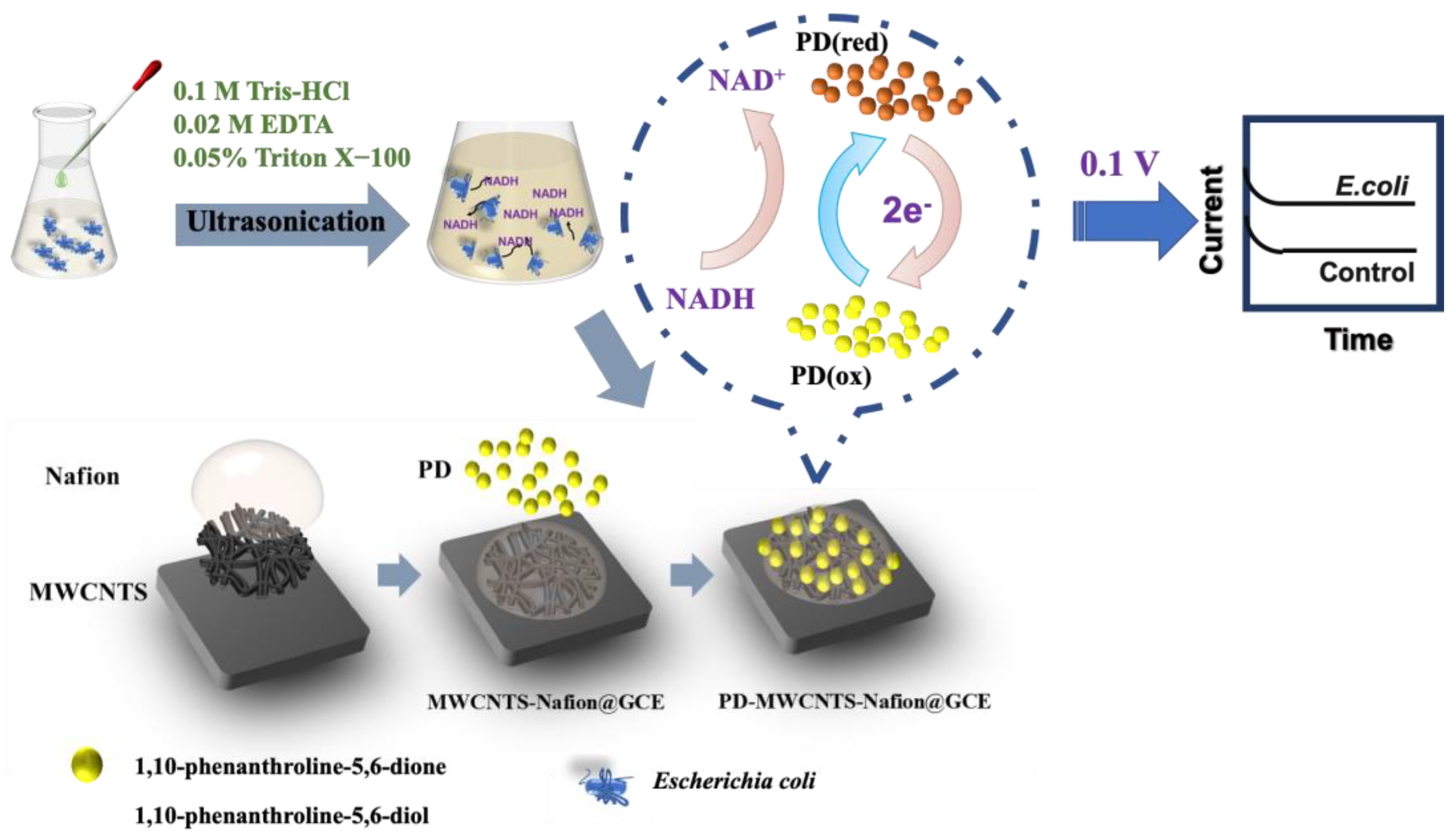

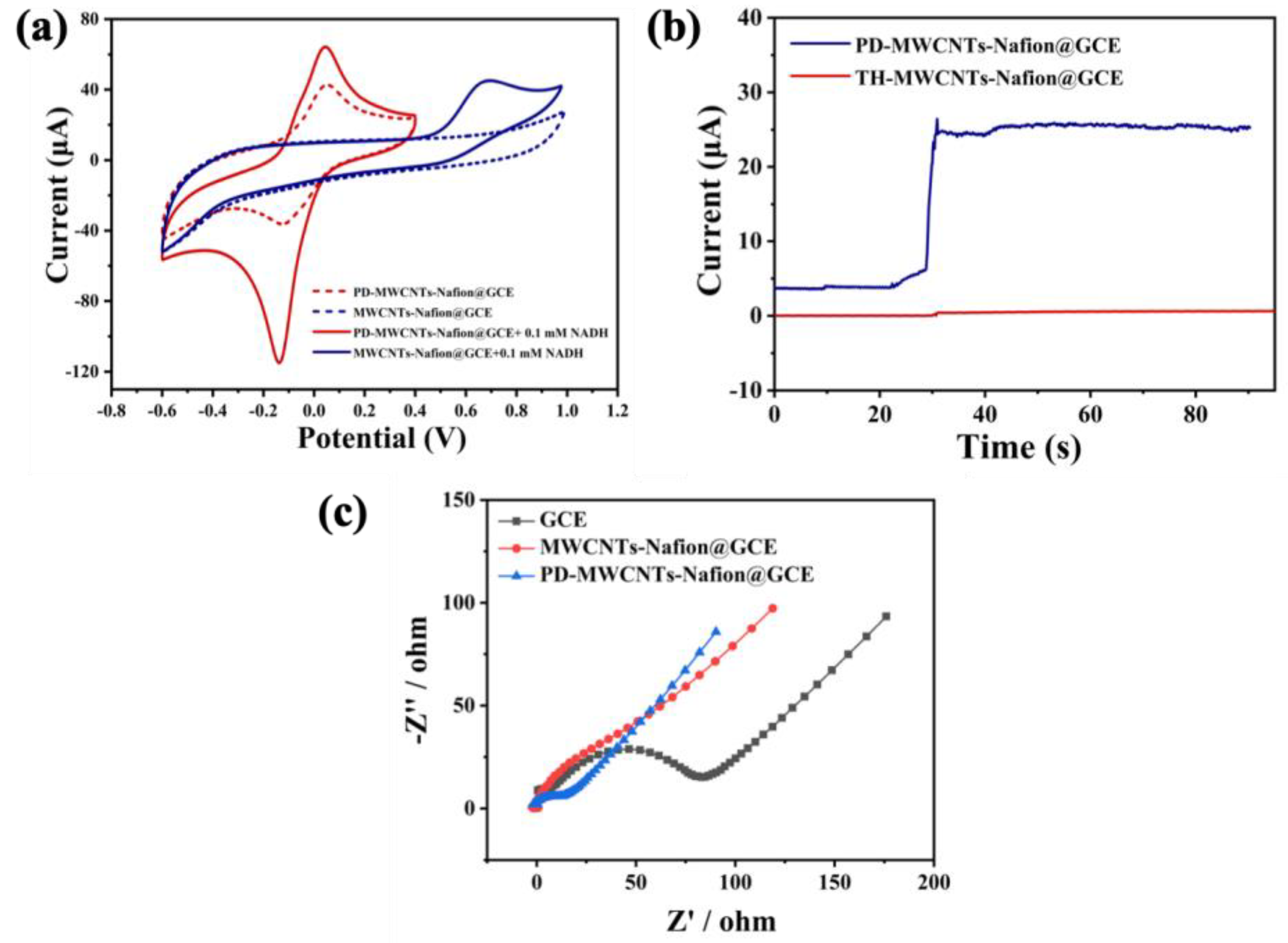
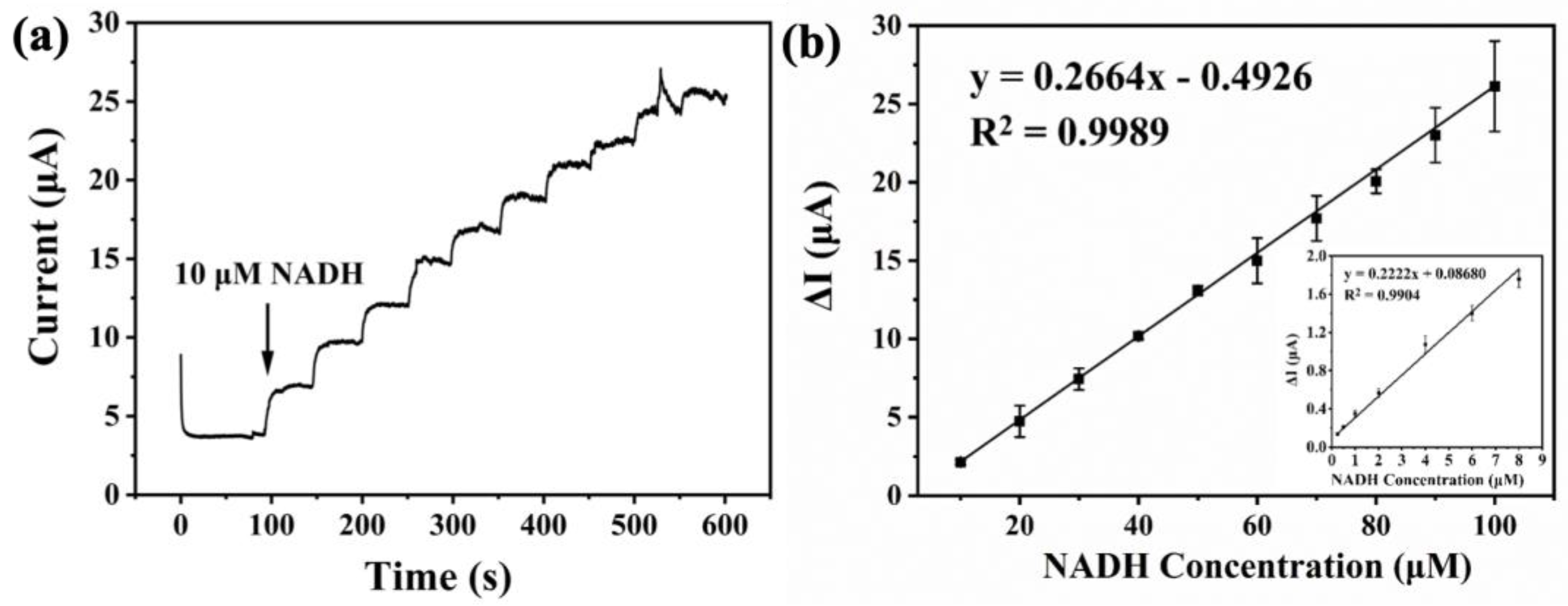
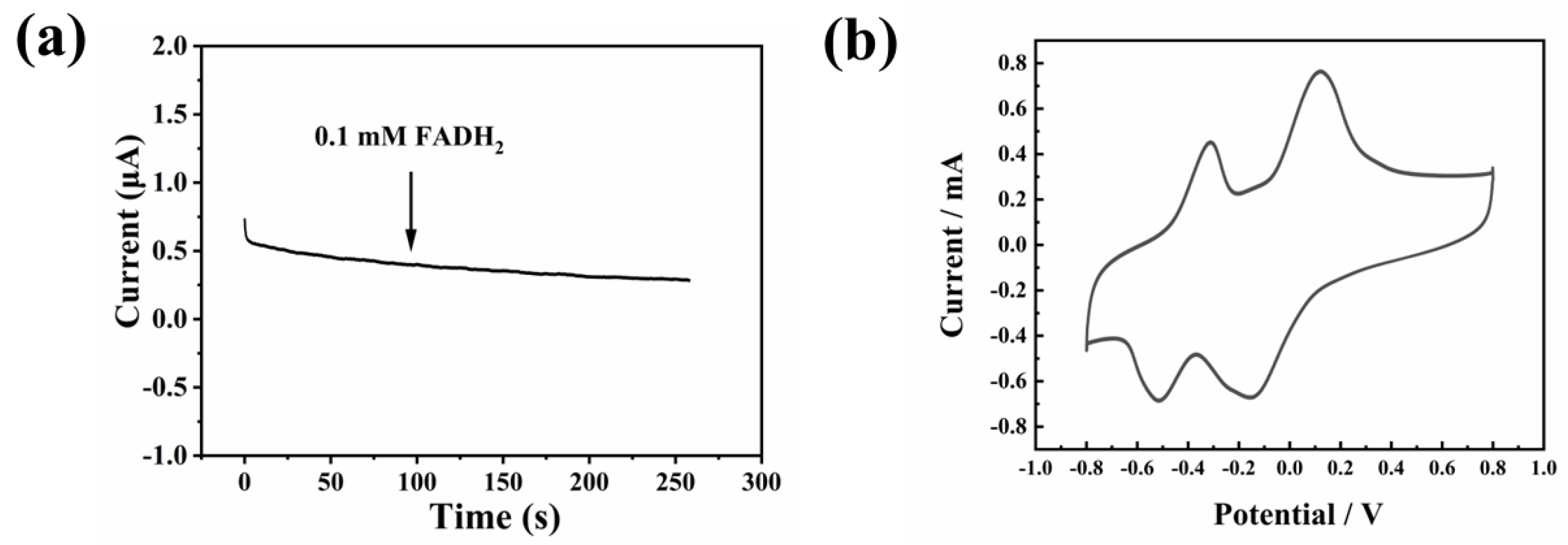

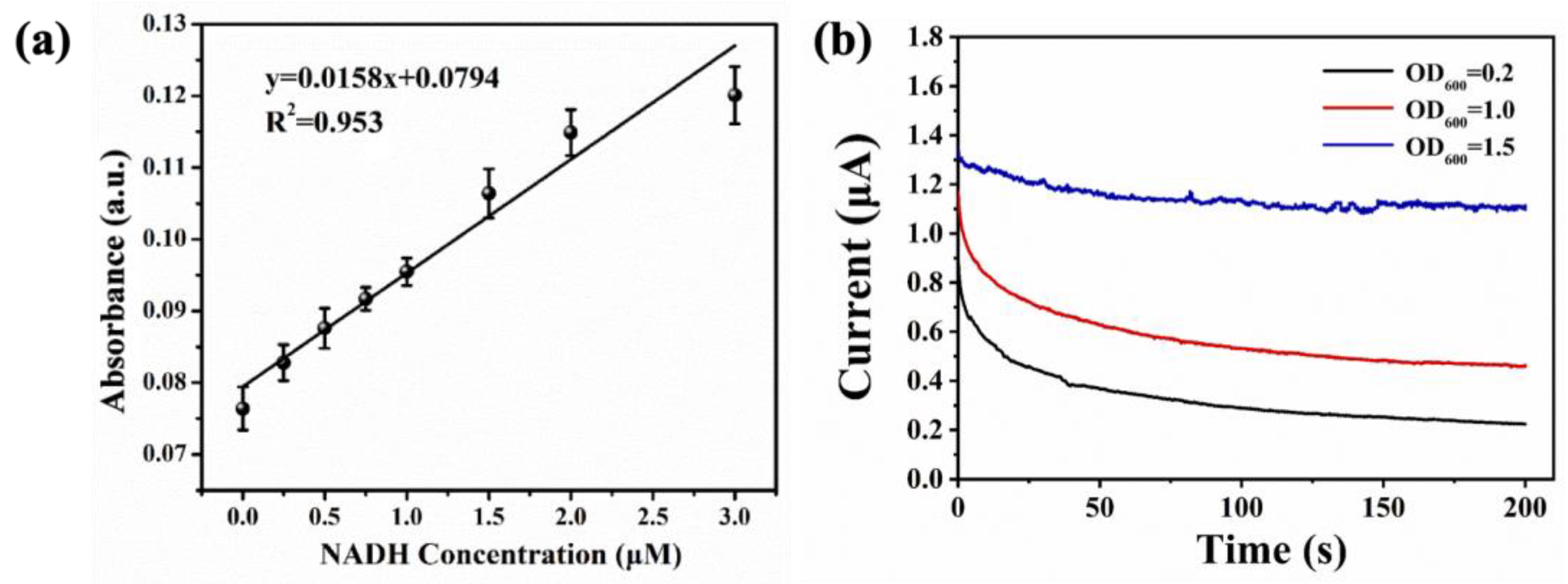
| Sensor | Detection Potential (V) | LOD (µM) | Linear Range (µM) | Sensitivity (µA/µM) | Ref. |
|---|---|---|---|---|---|
| CS–DA-MWCNTs-COOH/Au | +0.25 vs. SCE | 0.012 | 0.1–600 | 0.009 | [33] |
| PAA-MWNTs/GCE | +0.13 vs. Ag/AgCl | 1 | 4–100 | 0.094 | [34] |
| ERGO–PTH/GC | +0.4 vs. SCE | 0.1 | 10–3900 | 0.143 | [35] |
| CHIT/MWNTs/GC | +0.4 vs. SCE | 0.3 | 0.8–1600 | / | [36] |
| POA/GR@GCE | +0.045 vs. SCE | 1.3 | 0.166–1.772 | 47.1 | [37] |
| PD-MWCNTs-Nafion@GCE | +0.1 vs. Ag/AgCl | 0.0357 | 0.25–8, 10–100 | 0.222 | This work |
| Water Sample | NADH Concentration Detected with Electrochemical Sensor (µM) | Recovery Rate (%) | RSD (%) |
|---|---|---|---|
| Pu River | 0.086 | 89.12 | 8.26 |
| Tangwang River | 0.090 | 93.26 | 2.08 |
| Xueqing River | 0.088 | 91.19 | 4.45 |
Disclaimer/Publisher’s Note: The statements, opinions and data contained in all publications are solely those of the individual author(s) and contributor(s) and not of MDPI and/or the editor(s). MDPI and/or the editor(s) disclaim responsibility for any injury to people or property resulting from any ideas, methods, instructions or products referred to in the content. |
© 2023 by the authors. Licensee MDPI, Basel, Switzerland. This article is an open access article distributed under the terms and conditions of the Creative Commons Attribution (CC BY) license (https://creativecommons.org/licenses/by/4.0/).
Share and Cite
Fan, Y.; Liu, Y.; Gao, G.; Zhang, H.; Zhi, J. Development and Application of an Electrochemical Sensor with 1,10-Phenanthroline-5,6-dione-Modified Electrode for the Detection of Escherichia coli in Water. Chemosensors 2023, 11, 458. https://doi.org/10.3390/chemosensors11080458
Fan Y, Liu Y, Gao G, Zhang H, Zhi J. Development and Application of an Electrochemical Sensor with 1,10-Phenanthroline-5,6-dione-Modified Electrode for the Detection of Escherichia coli in Water. Chemosensors. 2023; 11(8):458. https://doi.org/10.3390/chemosensors11080458
Chicago/Turabian StyleFan, Yining, Yanran Liu, Guanyue Gao, Hanxin Zhang, and Jinfang Zhi. 2023. "Development and Application of an Electrochemical Sensor with 1,10-Phenanthroline-5,6-dione-Modified Electrode for the Detection of Escherichia coli in Water" Chemosensors 11, no. 8: 458. https://doi.org/10.3390/chemosensors11080458






